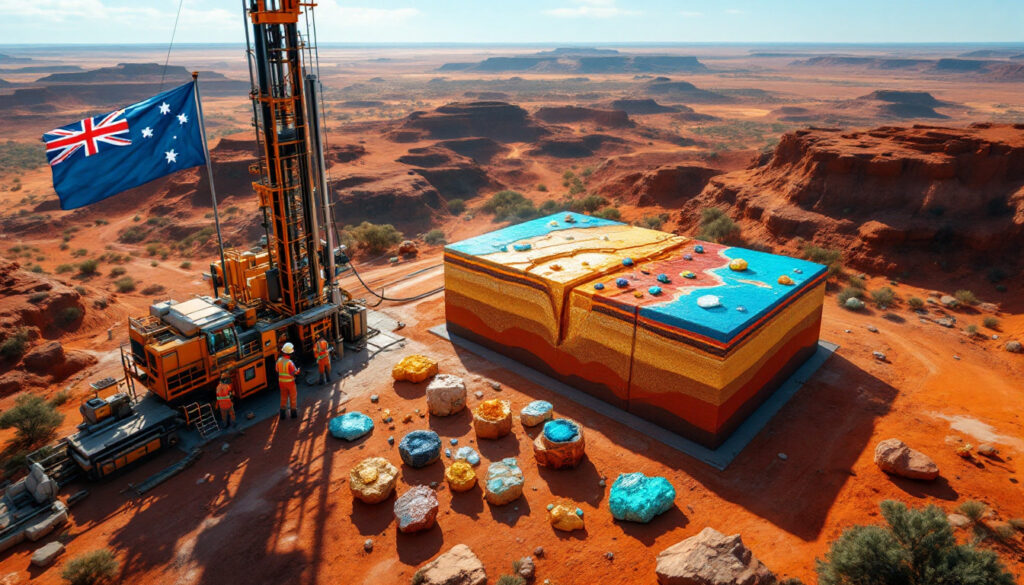What is the Western Australia Exploration Incentive Scheme?
The Exploration Incentive Scheme (EIS) is a strategic government initiative established in April 2009 by the Western Australian government to stimulate and accelerate mineral exploration across the state. This program offers co-funding for up to 50% of exploration costs, including drilling, geophysics, and energy analysis, with a particular focus on encouraging greenfields exploration in previously unexplored or underexplored areas.
The scheme operates on a twice-yearly application cycle, currently in Round 31, with $7.8 million allocated specifically for drilling projects across 49 companies in the latest round. This represents a significant portion of the total $11.2 million funding package designed to incentivize companies to venture into high-risk exploration territories.
As WA's Mines and Petroleum Minister David Michael notes, the EIS "plays a pivotal role in overcoming financial barriers that often prevent early-stage projects from reaching their full potential." This government backing has proven crucial for numerous discoveries, including Ora Banda's high-grade gold findings at Little Gem and Kingfisher Mining's rare earth element lode at the MW2 prospect.
Why is the Exploration Incentive Scheme Important for Western Australia?
The Economic Foundation of Western Australia
The mining industry represents the backbone of Western Australia's economy, contributing a remarkable 44% of the state's gross state product in the 2023-24 financial year. This substantial economic contribution underscores why the government continues to invest in programs that maintain the sector's vitality and ensure its long-term sustainability.
The EIS plays a critical role in this economic ecosystem by encouraging the next generation of mineral discoveries that will support future mining stocks guide opportunities, employment possibilities, and royalty revenues for decades to come.
Addressing Exploration Challenges
Greenfields exploration faces numerous challenges that the EIS specifically targets:
- High financial risk with uncertain returns on capital investment
- Limited geological data in unexplored regions
- Remote locations with difficult access and infrastructure requirements
- Longer timelines from initial exploration to viable discovery
- Uncertain returns on investment, especially in early stages
By covering up to 50% of direct exploration costs, the EIS significantly reduces the financial barriers that would otherwise prevent many junior companies from undertaking high-risk exploration projects. This is particularly important as 75% of geophysics grants under the scheme target potential new mineral deposits in areas with minimal previous exploration.
Companies like Yandal Resources (ASX:YRL) have demonstrated the scheme's value by discovering significant gold mineralization in the New England Granite during Round 28 funding, while Dreadnought Resources (ASX:DRE) identified high-grade niobium at their Stinger prospect with similar support.
How Does the EIS Co-Funding Program Work?
Funding Structure and Allocation
The EIS operates through a structured funding mechanism that strategically distributes resources across various exploration activities:
- Twice-yearly application cycles (currently in Round 31)
- Co-funding up to 50% of eligible exploration costs
- Round 31 allocated $11.2 million divided among:
- $7.8 million specifically for drilling (49 separate projects)
- Remaining funds directed toward geophysics and energy analysis
- Strong focus on critical minerals, with approximately 50% of drilling applications targeting these resources
- 75% of geophysics grants aimed at identifying potential new mineral deposits
The average grant size is approximately $180,000 per project, as exemplified by Buxton Resources' allocation for their Madman project. However, grant sizes vary based on project scope and potential impact, with some companies like Western Mines Group receiving substantially larger allocations of up to $440,000 for more extensive exploration programs.
Application Process
Companies seeking EIS funding must navigate a comprehensive application process:
- Submit detailed proposals outlining exploration targets and methodologies
- Demonstrate innovative approaches to testing geological concepts
- Show significant potential for discovering new mineral deposits
- Commit to public reporting of all results regardless of outcome
- Meet strict environmental and heritage protection requirements
Successful applicants receive formal funding agreements that specify milestone requirements and reporting timelines. A critical aspect of the program is that all results must be publicly reported and submitted to the Western Australian government's geological survey, enhancing the collective knowledge base available to all explorers.
Companies like Black Canyon (ASX:BCA) illustrate this process through their successful application to drill 3,000m across 150 reverse circulation holes at the Wandanya manganese project, having previously identified high-grade surface mineralization with assays showing up to 32.4% manganese from only 3m depth.
What Success Stories Has the EIS Delivered?
Recent Discovery Highlights
The EIS has contributed to numerous significant mineral discoveries across Western Australia, demonstrating its effectiveness in stimulating exploration success:
| Company | Discovery | EIS Round | Key Results |
|---|---|---|---|
| Ora Banda (ASX:OBM) | Little Gem | 29 | High-grade gold mineralization |
| Yandal Resources (ASX:YRL) | New England Granite | 28 | Significant gold mineralization in two drillholes |
| Dreadnought Resources (ASX:DRE) | Stinger prospect | 28 | High-grade niobium intercepts |
| Kingfisher Mining (ASX:KFM) | MW2 prospect | 29 | New rare earth element lode |
These discoveries highlight the scheme's ability to catalyze successful exploration across diverse mineral targets and geological settings. Ora Banda's work at Little Gem revealed impressive gold mineralization that might otherwise have remained undiscovered without the financial support provided through the EIS program.
Economic Impact
Beyond individual discoveries, the scheme has demonstrated considerable return on investment through multiple channels:
- New mineral discoveries leading to mine development and job creation
- Extended life of existing operations through near-mine exploration
- Increased geological knowledge of underexplored regions
- Enhanced international competitiveness of WA's mining sector
- Regional infrastructure development stimulated by exploration activities
Minister Michael emphasizes that the EIS ensures "sustainable resource development" by consistently replenishing the pipeline of mineral projects necessary for Western Australia's economic future. The program's public data-sharing requirements further multiply this impact by making new geological information available to all explorers, preventing duplication of effort and accelerating the identification of prospective areas.
Which Companies Received Round 31 Funding?
Black Canyon (ASX:BCA)
Black Canyon secured up to $122,500 in co-funding for their Wandanya manganese and iron project, enabling an extensive drilling program targeting high-grade manganese mineralization:
- Planned work: 150 reverse circulation holes totaling 3,000m
- Target highlights include:
- 3km long manganese target (only 240m tested to date)
- Previous results showing 5m at 31.1% manganese from surface and 5m at 32.4% manganese from just 3m depth
- Iron formations with assays up to 64.3% iron
This funding will allow Black Canyon to systematically test a significantly larger portion of their prospective manganese trend, potentially expanding the resource base for this critical battery material.
Buxton Resources (ASX:BUX)
Buxton Resources received $180,000 to advance exploration at their Madman project, located 375km northeast of Wiluna:
- The project features similar magnetic characteristics to the 8.4Moz Havieron gold-copper discovery
- Initial reconnaissance work has been completed
- Heritage survey requested to enable ground-disturbing activities
- Land access has been successfully secured
The Madman project represents a classic greenfields exploration opportunity that might otherwise struggle to attract private investment without the risk-sharing provided by the EIS program.
Errawarra Resources (ASX:ERW)
Errawarra Resources secured funding for their Andover West project, located 30km south-southwest of Karratha:
- Initially targeting mafic intrusion hosted nickel-copper mineralization
- Recently expanded focus to include lithium-caesium-tantalum (LCT) pegmatites
- Identified two prospective lithium pegmatite swarms along strike from Azure Minerals' significant discoveries
- Strategic position in an emerging lithium province
This funding demonstrates the EIS program's flexibility, allowing Errawarra to pivot toward lithium exploration as new opportunities emerged in the project area adjacent to major discoveries.
GreenTech Metals (ASX:GRE)
GreenTech Metals received grants for two distinct projects:
-
Whundo project (West Pilbara)
- Recent drilling results include 7.14m at 1.46% copper, 1.23% zinc, and 0.08g/t gold
- Additional intercepts of 9.94m at 1.32% copper and 0.18g/t gold
- Targeting volcanic massive sulfide (VMS) style mineralization
-
Osborne JV with Artemis Resources (15km southeast of Karratha)
- High-grade lithium pegmatites discovered
- Assays reaching up to 3.6% Li₂O
- Combined strike length of 5km across multiple pegmatite exposures
This dual funding approach allows GreenTech to pursue both base metal and battery mineral opportunities across their project portfolio, maximizing the potential for significant discoveries.
How is the EIS Advancing Critical Minerals Exploration?
RareX (ASX:REE)
RareX received substantial support totaling up to $160,000 for drilling plus an additional $15,000 specifically for mobilization to their remote Khaleesi project:
- Located in the Eastern Yilgarn region, 290km northeast of Kalgoorlie
- Targeting gallium, a critical mineral used in semiconductors with global demand rising approximately 12% annually
- Exploration results to date include:
- Aircore drilling returning up to 86g/t gallium
- Rock chip samples with up to 81g/t gallium
- Identification of a substantial 5km × 3km moderately mineralized body
- Planned work includes 300-1,300m of RC drilling across six priority targets
This focus on gallium aligns with Australia's Critical Minerals Strategy and positions Western Australia to supply essential materials for advanced electronics manufacturing.
Trek Metals (ASX:TKM)
Trek Metals secured $180,000 for their Christmas Creek project in the remote Kimberley region:
- Targeting the Martin and Zahn prospects
- Geological significance: Potential extension of the prolific Granites-Tanami Orogen gold province
- Previous results include:
- Martin prospect: Visible gold in high-grade intervals
- Zahn prospect: Wide zones of lower-grade gold mineralization suitable for bulk mining approaches
The Christmas Creek project exemplifies the EIS's effectiveness in enabling exploration in remote areas with significant logistical challenges that would otherwise deter investment.
Western Mines Group (ASX:WMG)
Western Mines Group received a combined $440,000 allocation for their technically challenging Mulga Tank project:
- Planned work includes three diamond drill holes targeting:
- The main body of the Mulga Tank Ultramafic Complex
- The Eastern portion of a significant Mobile MT geophysical anomaly
- A 1.3km long komatiite channel system with potential for high-grade nickel mineralization
The project's focus on komatiite channels is particularly significant as these geological features host many of Western Australia's most valuable nickel deposits, including the world-class Kambalda and Perseverance mines.
What Makes the EIS an Effective Government Initiative?
Strategic Resource Development
The EIS exhibits exceptional strategic alignment by targeting critical minerals exploration, with 50% of current drilling applications focused specifically on these increasingly essential resources. This approach:
- Positions Western Australia as a key supplier in emerging technology supply chains
- Diversifies the state's mineral production beyond traditional commodities
- Supports national economic security through domestic resource development
- Aligns with global demand trends for battery metals, rare earths, and technology minerals
Minister Michael emphasizes that the EIS enhances Western Australia's "international competitiveness" in attracting exploration investment, especially as global competition for critical mineral resources intensifies.
Knowledge Sharing Benefits
A uniquely valuable aspect of the EIS is its contribution to public geological knowledge:
- All funded exploration results must be publicly reported regardless of outcome
- Data becomes available through the Western Australian government's geological survey database
- Enhances collective understanding of the state's mineral potential
- Reduces unnecessary duplication of exploration efforts
- Creates a continuously expanding knowledge base that benefits all explorers
This public data requirement multiplies the program's impact far beyond the directly funded companies, as demonstrated by Kingfisher Mining's shared rare earth element data, which subsequently led to additional private investment in adjacent areas.
Long-term Economic Sustainability
According to Mines and Petroleum Minister David Michael, the EIS "plays a pivotal role in overcoming the financial barriers that often prevent early-stage projects from reaching their full potential." This approach supports multiple aspects of economic sustainability:
- Maintains a pipeline of future mining projects to replace depleting operations
- Creates sustainable regional employment opportunities beyond single mine lifespans
- Diversifies the mineral resource base to reduce economic vulnerability
- Attracts international investment to Western Australia's resources sector
- Generates long-term royalty streams to fund public services
The program's twice-yearly funding cycle ensures continuous support for exploration, avoiding boom-bust cycles that can disrupt the mining services sector and regional economies.
How Can Exploration Companies Access EIS Funding?
Application Requirements
Companies seeking EIS co-funding must meet comprehensive application criteria that ensure responsible exploration and maximum public benefit:
- Submit detailed exploration proposals with clear geological targeting rationale
- Demonstrate innovative approaches to testing geological concepts
- Show significant potential for discovering new mineral deposits
- Commit to public reporting of all results within 12 months of project completion
- Meet environmental and heritage obligations, including obtaining necessary surveys and approvals
- Provide detailed budgets showing matching private expenditure
The application process is competitive, with typically around 30% of applications receiving funding in recent rounds. This selectivity ensures that only the most promising and well-planned projects receive government support.
Upcoming Opportunities
The program operates on a predictable twice-yearly cycle, with applications typically opening in:
- March/April for the mid-year funding round
- September/October for the end-of-year funding round
Companies planning exploration programs should monitor the Department of Mines, Industry Regulation and Safety website for announcement of Round 32 applications. Early preparation is essential, as successful applications typically include comprehensive technical justification, clear targeting rationale, and detailed implementation plans.
Additional support is available for remote projects through mobilization grants of up to $15,000, as demonstrated by RareX's funding package for their Khaleesi gallium project. These supplementary funds recognize the increased costs associated with exploring Western Australia's most remote regions.
FAQ About Western Australia's Exploration Incentive Scheme
How successful has the EIS been since its inception in 2009?
Since its establishment in 2009, the EIS has co-funded more than 1,200 exploration projects across Western Australia. The program has contributed to numerous significant mineral discoveries, helping to maintain the state's position as a global mining leader. Independent economic analysis has shown that the program delivers substantial return on investment through new resource discoveries and expanded geological knowledge, with benefits extending far beyond the directly funded companies.
What types of exploration activities qualify for EIS funding?
The scheme co-funds various exploration activities including:
- Diamond drilling for detailed geological information
- Reverse circulation drilling for rapid testing of targets
- Aircore drilling for shallow reconnaissance
- Geophysical surveys including gravity, magnetic, and electrical methods
- Energy analysis including petroleum and geothermal exploration
The focus is primarily on innovative approaches to testing geological concepts in greenfields areas where existing data is limited and exploration risk is highest.
Are international companies eligible for EIS funding?
Yes, international companies with appropriate Australian business registrations and exploration licenses in Western Australia can apply for EIS funding, provided they meet all other eligibility criteria. This international accessibility has helped attract global exploration investment to Western Australia, further strengthening the state's position as a world-leading mining jurisdiction.
How does the EIS benefit the broader Western Australian community?
The EIS generates wide-ranging benefits beyond direct mining employment:
- Stimulates economic activity in regional areas through exploration services
- Supports local businesses including accommodation, transport, and supplies
- Contributes to infrastructure development in remote regions
- Helps sustain government revenue through royalties and taxes from successful mining operations
- Creates educational and research opportunities through public data availability
- Provides sustainable career pathways in the resources sector
Infrastructure developments in communities like Wiluna benefit from exploration activity at nearby projects such as Buxton's Madman project, creating lasting improvements that serve the broader community.
Further Exploration Opportunities
Western Australia's mineral exploration landscape continues to evolve, with the incentive scheme in Western Australia playing a central role in driving new discoveries. Companies and investors interested in participating in this dynamic sector should:
- Explore the Western Australian Department of Mines, Industry Regulation and Safety website for detailed information about upcoming funding rounds
- Review previous successful projects to understand effective application strategies
- Consider the strategic advantages of exploring for critical minerals given their growing global importance
- Recognize the value of public geological data in reducing exploration risk
Want to Stay Ahead of the Next Major ASX Mineral Discovery?
Discovery Alert's proprietary Discovery IQ model delivers instant notifications about significant mineral discoveries, empowering investors to identify actionable opportunities before the broader market. Explore how historic discoveries have generated substantial returns by visiting the Discovery Alert discoveries page and position yourself for market-leading advantage.




